Wanbi
Much of the Murray Mallee comprised (and still does) dune and swale systems with soils of low fertility. The sand dunes are prone to erosion and many of the flats contain deposits of limestone. Originally most of the land was covered by dense mallee scrub.
Before the 1900s, parts of Murray Mallee region were leased for grazing. Severe droughts in the 1890s forced pastoralists off the land due to a lack of feed and water and the impacts of rabbits.
The SA Government introduced programs to encourage the clearing of vegetation and the cropping of land, with widespread clearing occurring very quickly over a 25-year period from the early 1900s.
Part of the Government’s encouragement to develop regional SA was to construct railways. The railway from Tailem Bend to Pinnaroo opened in 1906 and that to Loxton was opened in 1914 allowing efficient transport of primary produce (and people). Spur lines were also completed to Peebinga, Paringa, Waikerie and Yinkanie. Farming settlement quickly followed the railways.
The processes of subdivision and allocation of properties failed to take into account the difficulties farmers would face. Properties were small, money short, and living conditions harsh. Cropping was the main enterprise – wheat for sale and oats to feed the horses. Few sheep were run because farmers needed cash, there were no materials for fences, and water supplies were unreliable. There was minimal use of superphosphate and fallowing/frequent cultivation was the norm.
Before Wanbi Research Centre
The Department of Agriculture supported the expansion of agriculture into new areas by establishing experimental farms. These farms did research and development and supported the extensive trial work done by Agricultural Bureaux in the region.
In 1908 a research farm was established west of Loxton. This 600-acre farm operated until 1913 when it was deemed to have shown that agricultural production could be undertaken in this area. The Loxton farm was linked to another, established at the same time, at Veitch’s Well near Alawoona. This farm of 4000 acres operated until 1930 and was closed for financial reasons.
For further information: Loxton and Veitch's Well - History of Ag SA (pir.sa.gov.au)
The period leading up to the purchase of Wanbi was characterised by several droughts, poor grain prices, depression, wars, and shortages of inputs like fuel and fertiliser. Farmers were not experienced in managing the sandy mallee soils under these conditions and extensive erosion occurred.
By the early 1940s much of the Murray Mallee was severely eroded, and many farmers had abandoned their properties.
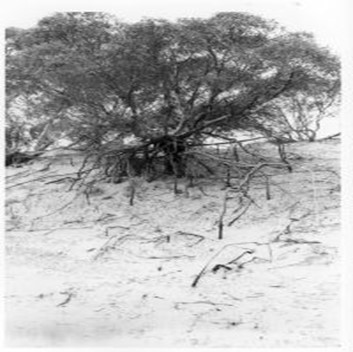
Roots of a mallee tree exposed by soil removal through erosion
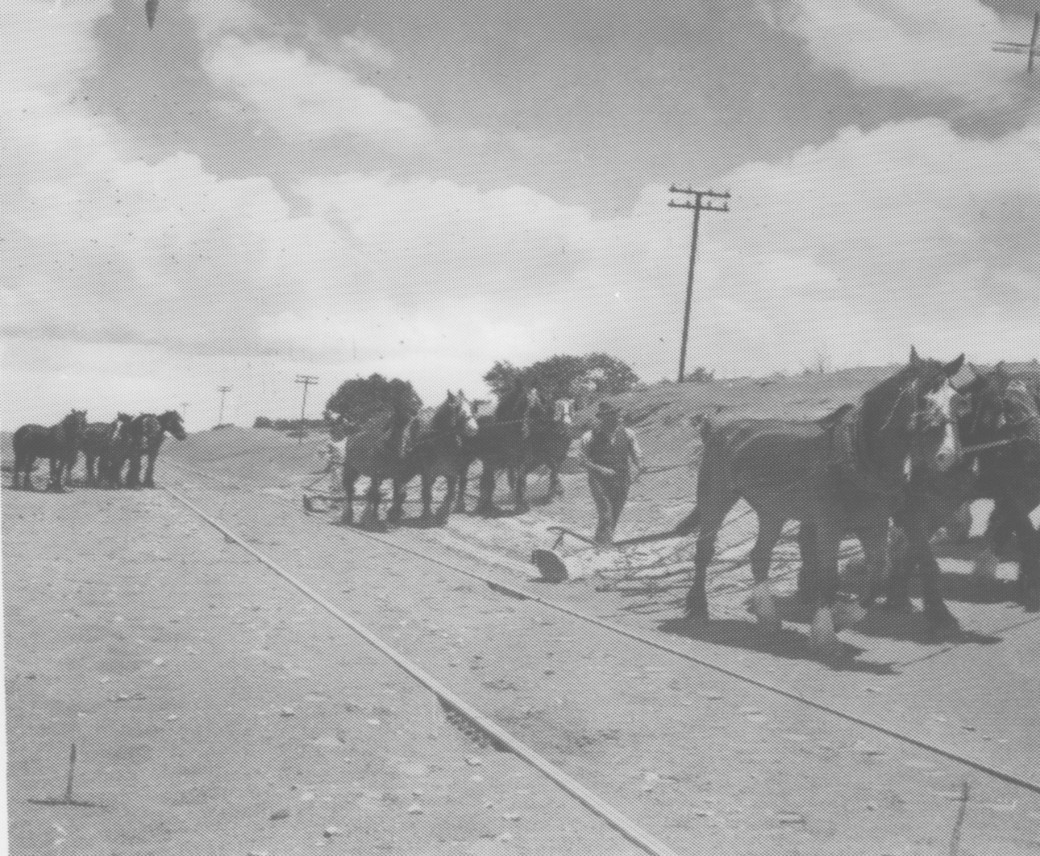
Public utilities were impacted - clearing sand of the railway at Nunkeri, in the 1940s
The Murray Mallee Soil Conservation District and Board was formed in 1947 (the first in SA) with the main purpose of investigating and encouraging the use of better soil management practices to manage erosion and improve productivity. The Board was supported by Soil Conservation Officers from Adelaide and Paul Geurin, Wanbi Manager, until the early 1960s when an appointment was made to Loxton to cover the entire mallee region.
Part of the Board activity was to establish a Centre on which improved soil conservation practices involving cropping and sheep management could be developed and demonstrated to farmers.
The Wanbi Research Centre
The Wanbi Research Centre which adjoined the Karoonda Highway near Wanbi township, between Karoonda and Loxton, was purchased in 1952, although about one third was a Soil Conservation Reserve which had been declared in 1945. This reserve included the largest sand dune in the mallee (otherwise known as “the big hill”) which ran for 10 km NW-SE in the area between Mindarie and Wanbi.
The Centre of 1424 ha, of which 1350 ha was arable had some of the most difficult soils in the Mallee. That was one reason for the site being chosen.
The Centre was first staffed in 1953. It normally comprised a manager, 2-3 farm hands and an office person. Most lived on site. At no time did Wanbi have resident research staff, programs were run by those in Adelaide or other centres, sometimes with technical support at Wanbi.
The farm equipment was generally obsolete and unreliable when compared with that of local farmers. Budgets for cropping, livestock and general maintenance were inadequate and did little for morale or standing in the local community. Despite these constraints, its commercial farm program made a significant contribution to meeting its expenses and contributed to the State coffers. In fact, the Review of Research Centres in 1983 indicated that Wanbi was one of the few centres where farm revenue exceeded expenses in most years.
Managers over the period included staff from Soil Conservation Branch initially, Paul Geurin, Tony Morris, Gerry Woodroffe, Struan staff for a period, Colin Cawthorne, John Squires, and David Pocock.
The isolation of the Centre and the limited local facilities, unlike most other centres, presented staffing and operational challenges which were often not well understood by Departmental management – often it was a case of out of sight, out of mind. This was exacerbated by the Centre often being treated as just another site by external research staff with little inclusion of local staff in the research itself.
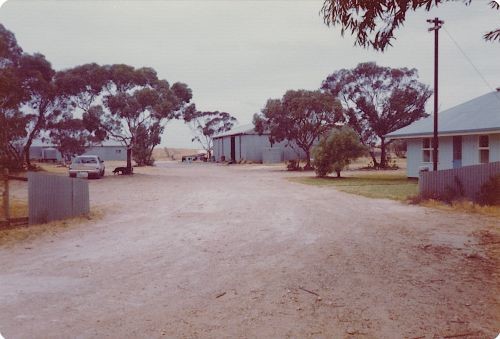
Offices and Sheds at Wanbi Research Centre – modest by any standard
Programs
It is not surprising that most of the programs at Wanbi related to improved soil conservation practices.
Sand Dune Stabilization
Early work concentrated on “the big hill” and involved hand planting of Pyp grass. This soon moved to the use of cereal rye, superphosphate with added N at seeding, and the use of perennial veldt grass. There was no heavy machinery and work was mainly done with conventional equipment often on very steep slopes which presented dangers to staff which would be unacceptable today. The aim was to progressively reduce the eroded areas by preventing “recharge” of sand from nearby eroded areas. The program took several years to achieve full cover.
This work highlighted aspects of dune stabilization which were adopted by many farmers across the Mallee and Eyre Peninsula. But many eroded areas remained in the district until many years later when a government funding program supported use of heavy machinery, fencing etc.
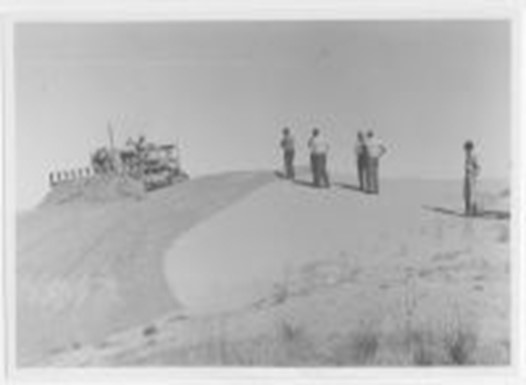
Bulldozing the crest off a dune prior to seeding – Mindarie 1956
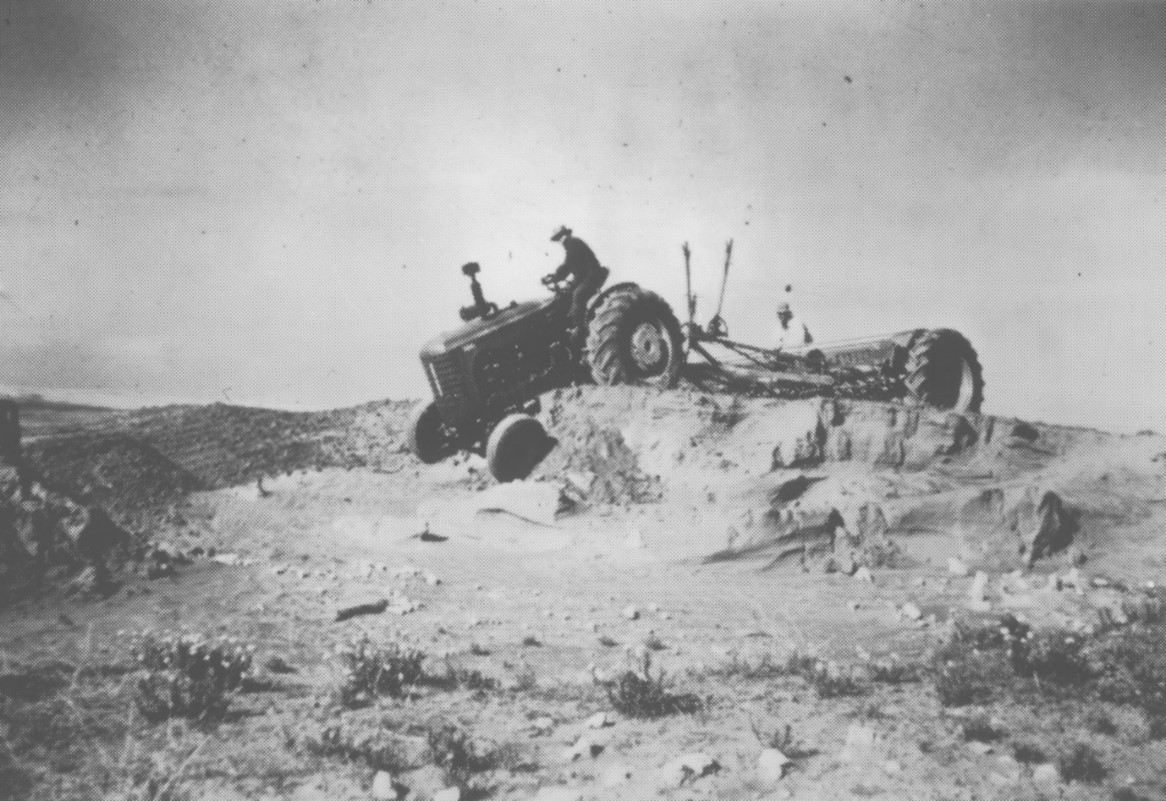
Seeding rye on Wanbi Research Centre in 1953
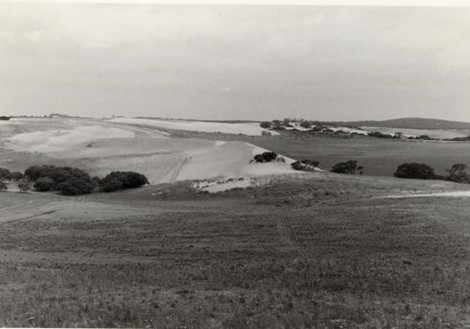
The “big hill” tamed – the stabilized dune on Wanbi Research Centre in the foreground, looking towards the still eroding areas on the neighbouring property.
Farming According to Soil Capability
The erosion risks of over cultivation and grazing by sheep were well known. There was clearly a need to crop and graze according to land type and capability.
Wanbi played an important role in this by demonstrating fencing of different types and how each could be farmed for greater profit and less risk. This was part of a “farm planning” program adopted by the Board and Soil Conservation staff in the early 1960s.
An essential part of this was the placement of watering points which resulted not only in less overgrazing but in improved sheep productivity. This became an integral part of the “farm plans”.
Cereal and Pasture Improvement
Wanbi was a site for many variety trials, firstly with wheat and then with barley as its value on light sands was realized. This included being a major site for seed build up and delivery to farmers of new varieties. Trials were also conducted on legume varieties, especially medics and lucerne.
The value of these trials, and others, was realized with the establishment of the “three-year rotation” – wheat – barley – medic (and without fallow), which became common not just in the Mallee but across the State and an integral part of “farm plans”. It had the benefits of erosion management, fertility build up, providing for livestock needs and improving productivity.
Fertilisers
Wanbi led the way in fertilizer practice for dune control and contributed to developing rates of superphosphate (in crop and across the rotation to build reserves) and in nitrogen at seeding and in crop using urea and ammonium sulphate, including, timing according to crop growth, and methods of application. These were part of Statewide programs and Wanbi was a key site for research and demonstration.
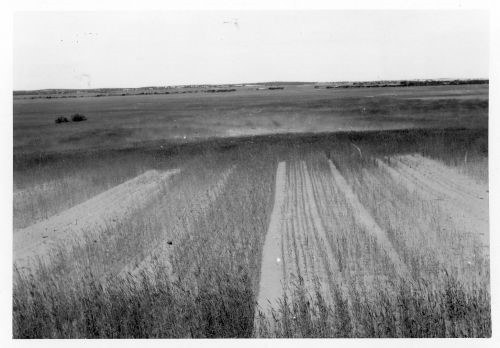
Trial using Sulphate of Ammonia added to superphosphate to encourage early growth of cereal rye on dunes – Wanbi 1958
Weed Management and Tillage
Wanbi was part of Statewide programs to trial and demonstrate weed control, especially in the days when hormone herbicides were common and pre seeding sprays had just been introduced. Their work revolved around rates and timing according to both weed and crop stage. The results of these programs form part of practices used today.
Wanbi had more than its share of more difficult species which were common in parts of the Mallee – such as false caper, onion weed and horehound. The effectiveness of herbicides was limited and so farmers resorted to cultivation (“hit ‘em with cold steel" was the catch cry). This of course increased erosion risk.
Wanbi was a pioneer in researching and demonstrating the emerging minimum tillage technologies of the day, in particular the blade plough, rod weeder, and trash clearance modifications on combines. This work was funded by the Rural Credits Development Fund (one of the few sources available at the time) and overseen by Dr Bob Fawcett.
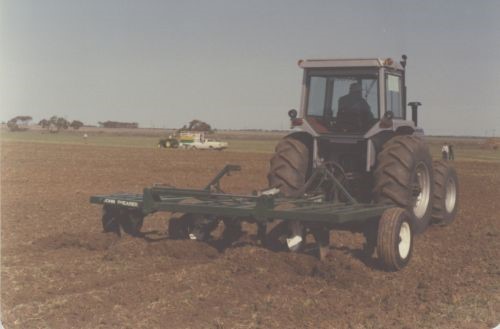
Demonstrating blade plough – Wanbi Research Centre 1979
Large numbers of farmers from the Mallee and elsewhere attended site field days and monitored the outcomes closely. By signaling that there was an alternative to conventional equipment, it served as a catalyst in changing attitudes towards regular cultivation. Farmers and manufacturers were quick to modify and build different machines.
Sheep Management
The need to contain sheep during periods of low feed availability, as well as drought, was obvious, not just for soil conservation, but for sheep productivity.
Wanbi ran a large trial and demonstration to explore suitable rations, the need for supplements (such a ground limestone), the most efficient trough feeding and watering methods, control of fly strike and internal parasites, and protecting the native shade vegetation in the containment area. This work was done in conjunction with livestock and veterinary staff from Adelaide and became the benchmark in containment feeding. The same management principles are used today.
Other sheep related activities conducted at Wanbi involved fly and parasite management, mulesing, sheep classing, hogget competitions, yard and shed design, shearing schools, shed and shearing management, and wool schools. All were provided by outside experts and were very popular with farmers.
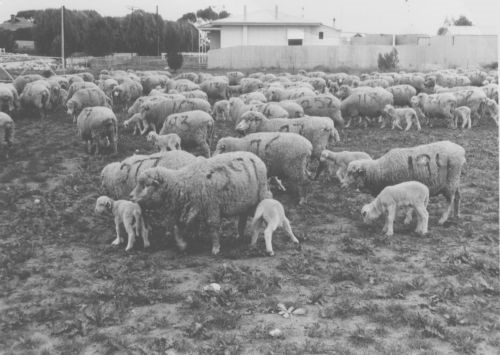
Sheep feeding trial – Wanbi Research Centre 1962
Wanbi was also involved in “chemical shearing” with CSIRO, which was less than successful. It also took part in the early copper and cobalt deficiency work, although they were never the issue that they were in the Southern Mallee and beyond.
The Place of Cattle
Few farmers in the mallee ran cattle, despite the obvious fact that they did less erosion damage.
In a period in the late 1970s Struan Research Centre ran a program at Wanbi comparing the feed requirements and performance of dairy vs beef-breed cows (dairy did better even during drought). The trial did not include measurements of ground cover, species composition etc, nor did it include an economic evaluation. As such it had little relevance to Mallee farmers.
Fodder Conservation
Wanbi was involved in many fodder conservation and feeding research and demonstration programs (especially in drought as previously noted). These included conventional methods as well as ensilage and the use of Jayhawk equipment. One notable approach was the storage of barley and oats (in particular) in bunkers dug in the side of sand hills. It worked, but only if careful note was made of bunker location! It was well before the days of GPS.
A Farming Systems Comparative Approach
In the 1980s a proposal was developed to compare the profitability and risk of cropping vs livestock in farm systems. An initiative of Geoff Thomas, (then Murray Lands Chief Regional Officer), and Venton Cook it was based on the approach used in a trial at Pigeon Ponds in Victoria and informed by its scientific staff. The purpose was to better understand the profit/risk components of farming systems. It was a bold and complicated exercise, in terms of management, measurement and analysis. It was applauded by farmers but the logistics of field measurements and using untrained staff proved too difficult. Being a long-term exercise, it was discontinued when it became obvious that the Department intended to close Wanbi.
Extension and Demonstration
Wanbi conducted regular demonstrations and workshops for farmers and their wives. These were supported by, and often organized by, an Agricultural Bureau or Women’s Ag Bureau.
Major Field Days were held about every two years with between 300 and 500 farmers attending, including from areas outside the Mallee and from interstate. These field days were generally opened by the Director General or a local dignitary. Programs were diverse and included not just sessions related to farm practices per se but on subjects like tree planting, farm safety, fire prevention and control, as well as homemaker and gardening subjects.
Farmers were frequently accompanied by their wives in what was really a learning event with a strong social component, some of which played out in the Wanbi Hotel afterwards. Wanbi Research Centre was truly part of the community.
In the End – Closure
There were several influential people in the Department who had advocated for the closure of the Centre for some years despite not being familiar with its programs. not having assessed its future role and potential, or having consulted with farmers. They saw it as irrelevant and a source of cost saving - small as they were.
The Review of Research Centres in 1983 noted that “as low-cost research/demonstration centres, Wanbi (and Minnipa) appear to be working efficiently” It was further noted that “unlike several other Centres, they had close contact and involvement of local farmers”.
But the fact was that Wanbi Research Centre had served its purpose and its future role was unclear.
The world had changed. Research leaders, most of whom were based outside the region were less interested in engaging; scientific field equipment was more sophisticated allowing more on farm sites to be used; it had become increasingly difficult to attract staff to Wanbi, the community has diminished to the point where they was less social support; farmers were seeking information from private providers as the public service shrank; and generally there was less appreciation understanding of the importance of science, industry or rural communities. The Department was changing.
An agreement was struck with local farmer groups that Wanbi would be sold on the understanding that agronomy services would be maintained at Loxton.
The property was sold in 1994 to a local farmer who proudly displays the sign WANBI FARM out the front.
There is clear photographic evidence of the early extent and nature of wind-blown soil erosion in the Mallee. Not only was there loss of valuable topsoil from these regular events, crops and sheep production was low and variable.
Stabilisation of dunes and application of minimum tillage, and other crop and sheep management practices using the technologies developed in part at Wanbi have essentially removed the problem of soil erosion. Productivity and profitability have increased to the extent that the area is no longer considered marginal land for cropping.
So, after 40 years of endeavor, Wanbi Research Centre closed with the farming community well experienced in managing sand drift and dune stabilization, innovations in drought feeding of sheep, and adoption of integrated cropping and livestock farming systems including reduced tillage. Farmers today still recognizing its achievements. One cannot say that Wanbi was a leader on its own, but it did contribute to many research and extension programs which had a significant impact on farming practices and land care.
Acknowledgement
Author: Geoff Thomas
Date: March 2024
